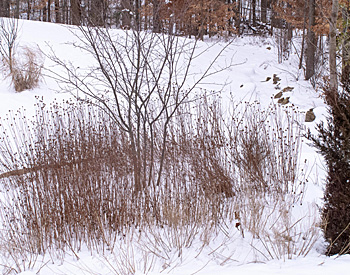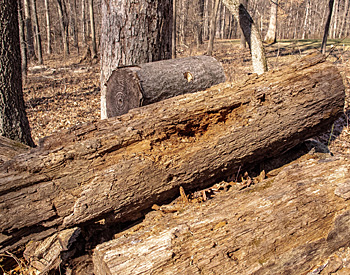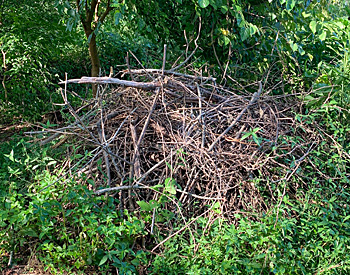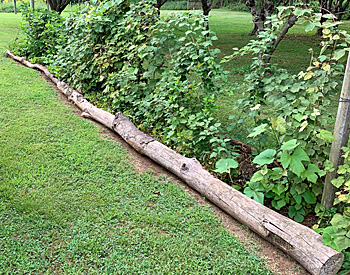Volume 24 Issue 4, Fall 2019
by Anne Owen, Audubon at Home Coordinator
As late fall approaches with its colder weather, the final blooms of the year fade, the last of the leaves fall from our deciduous trees, and many of us will be thinking of “tidying up” the yard, with a sense of “putting things to bed” until spring. That may mean cutting down those dead perennials, trimming shrubs, raking up leaves, and putting bagged yard waste at the curb for pickup. It might even mean enjoying a bonfire!
Before you do any of this, please spare a thought for the wildlife that will be looking for safe spots to survive the winter. Consider leaving them with “winter quarters.”
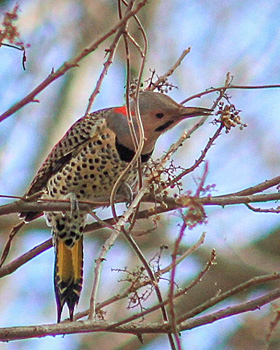
A Northern Flicker makes a meal of some Poison Ivy berries in a Loudoun yard. Photo by Brian Magurn
Many of our wildlife residents will remain hidden from view during this season, and the insects and spiders that overwinter successfully are the ones that provide early food for hungry birds in the spring. They will pollinate the early flowers, providing fruit and seeds later in the season. Many butterfly and moth species overwinter as pupae in leaf litter. When the adults emerge in early spring, they lay eggs and begin to provide the critically important caterpillars that almost all our breeding birds need to feed their young.
Ladybugs and Lacewings like to nest in dry, sheltered crowns of native grasses, and spiders hide at the base of old stems. Some species of native bees use hollow plant stems or small holes just below or on the ground’s surface to overwinter, while others will have laid their eggs in dead wood to wait out the winter as grubs. Wood frogs and spring peepers will seek out deep crevices in logs or rock piles or dig down as far as they can in leaf litter to hibernate. Fence lizards will also retreat to hiding places in tree holes, under bark, or in rock pile crevices.
Even species such as birds that are active in the winter months need food and shelter. Birds will greatly appreciate the seed heads of grasses and forbs such as Coneflower. Standing stems and grasses will also provide safe spaces for small birds to escape ever-present predators such as hawks. Visiting Dark-eyed Juncos and White-throated Sparrows love the brush piles in my yard!
There are a lot of things that you can do to provide winter quarters that will make a difference to wildlife.
- Leave stems and seed heads standing through the winter months. If you are not comfortable leaving all of it, consider cutting down just a part and leave a section standing. Stems left standing can protect the plants themselves in severe weather by collecting insulating snow. If you do cut your perennials, think about leaving the cut stems in a loose stack on the ground out of the way, to form a small brush pile that can provide winter habitat. Add trimmings from shrubs to bulk out the pile.
- Let leaves lie where they fall, or just blow them off the lawn and make a pile at the back of the beds. Natural leaf litter provides shelter for many species and is a great natural mulch.
- Trim any dead trees (snags) for safety, then leave them standing. If you must fell them, reserve some of the cut logs to make a woodpile in a quiet corner that you can leave to slowly return to the earth. You can add an attractive dead branch to a flower bed for visual interest or even use dead wood as a lowcost, ecologically friendly edging. Dead wood in all its forms has great wildlife value.
- If you plan to burn a brush pile, do your best to make sure that there are no critters inside — you can disturb the pile vigorously, or even move it to a new spot before burning, but it would be preferable to wait until spring when any hibernating critters have had the chance to wake up and move out.
Providing safe places for our native wildlife to overwinter will go a long way to kick-starting the food web in spring!
